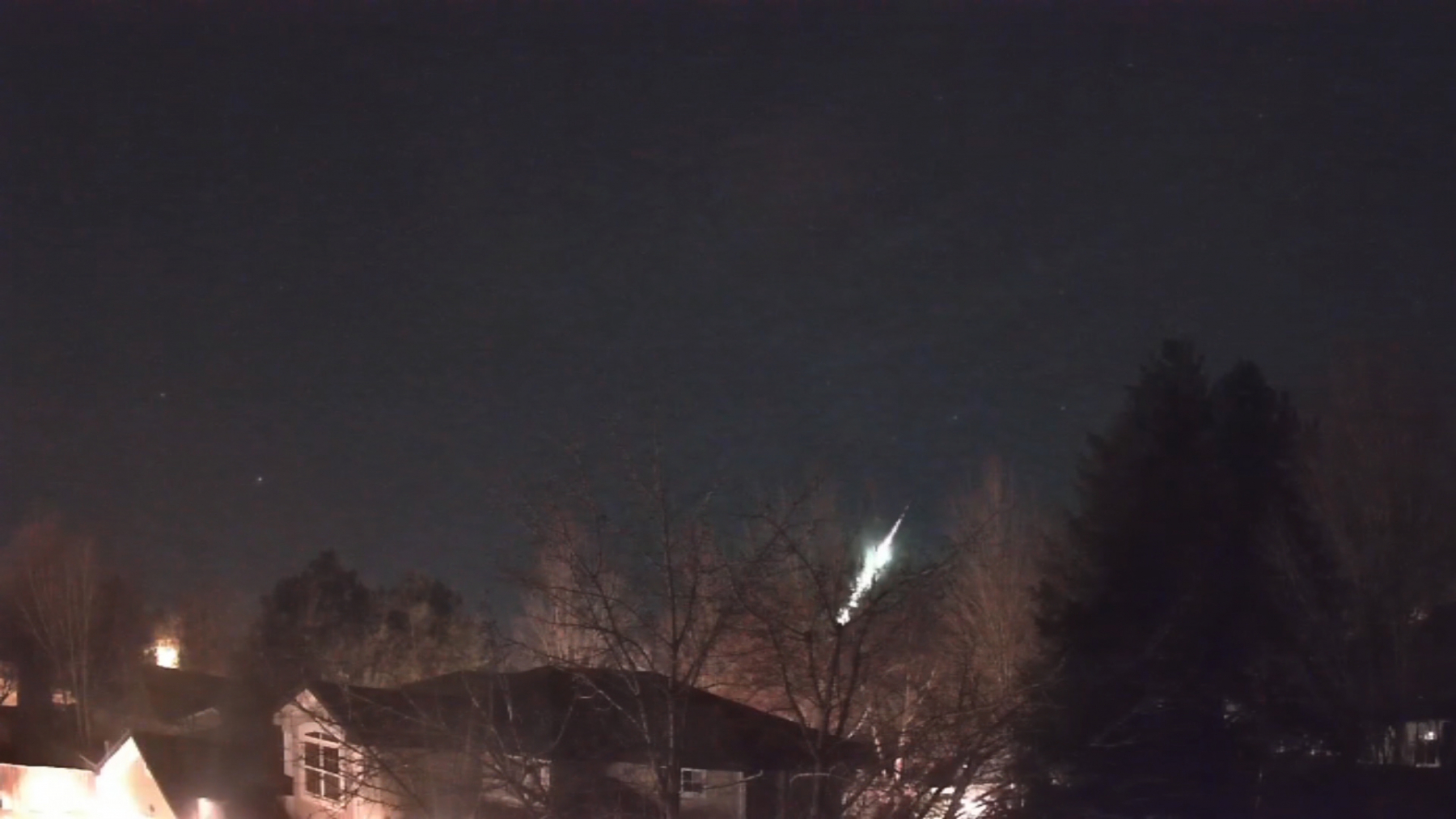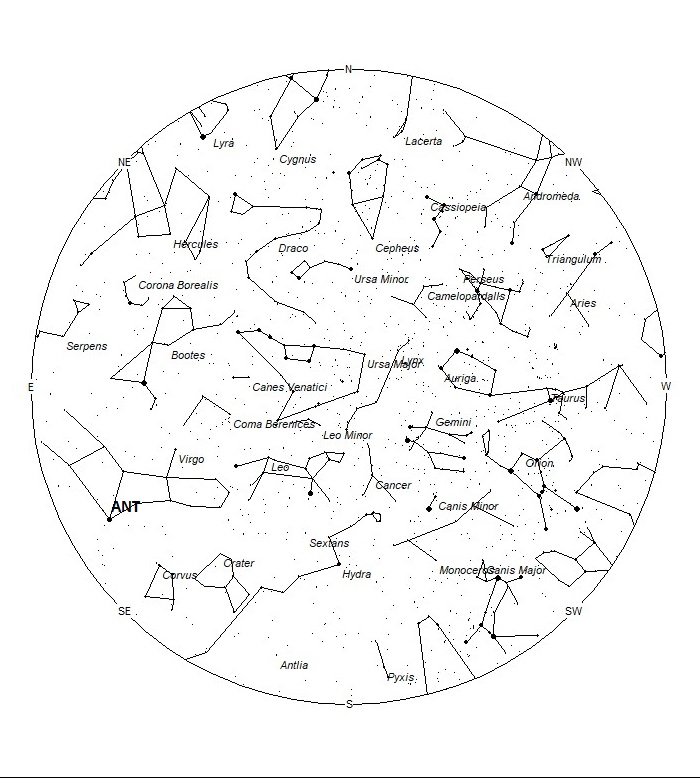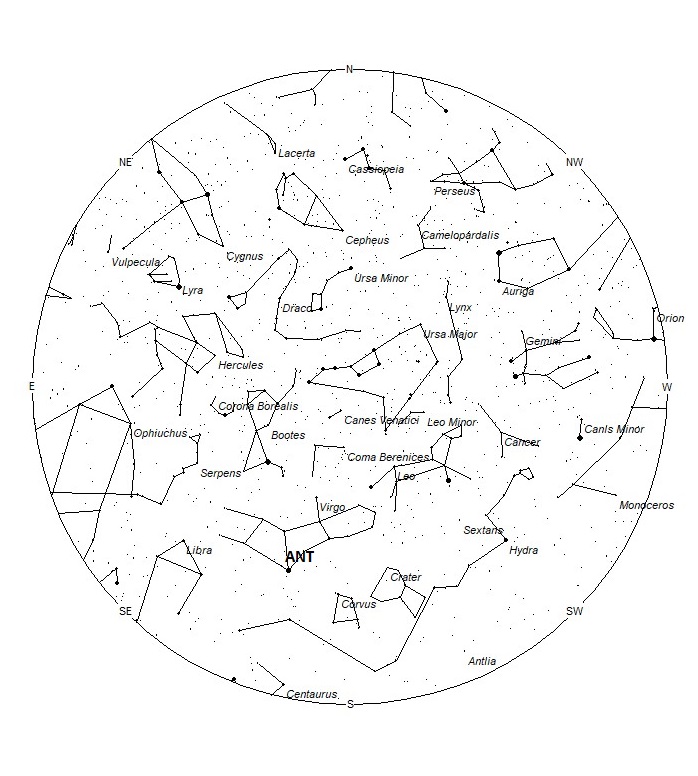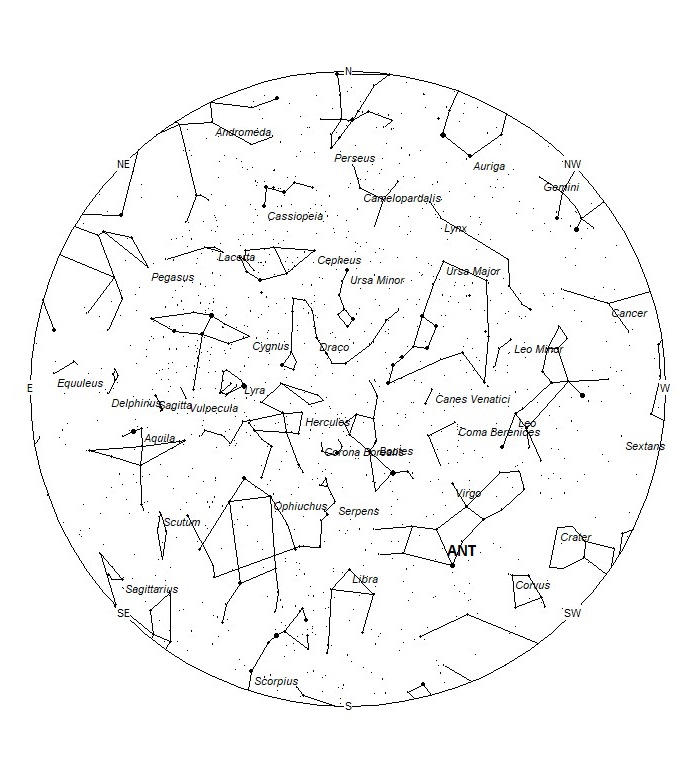 Jordan Ragsdale captured this short but bright fireball using his AllSky Camera System on February 4, 2022 at 5:49 MST (12:49 UT) from Eagle, Idaho, USA. More observations of this event are available at: https://fireball.amsmeteors.org/members/imo_view/event/2022/868 . ©Jordan Ragsdale
Jordan Ragsdale captured this short but bright fireball using his AllSky Camera System on February 4, 2022 at 5:49 MST (12:49 UT) from Eagle, Idaho, USA. More observations of this event are available at: https://fireball.amsmeteors.org/members/imo_view/event/2022/868 . ©Jordan RagsdaleDuring this period, the moon reaches its new phase on Friday April 1st. At that time the moon lies near the sun and is invisible at night. This weekend the waning crescent moon will rise during the early morning hours and won’t interfere with meteor observing as long as you keep it out of your field of view. For evening observers, the estimated total hourly rates should be near 2 as seen from mid-northern latitudes (45N) and 3 as seen from tropical southern locations (25S) For morning observers, the estimated total hourly rates should be near 6 as seen from mid-northern latitudes (45N) and 10 as seen from tropical southern locations (25S). The actual rates will also depend on factors such as personal light and motion perception, local weather conditions, alertness, and experience in watching meteor activity. Morning rates are slightly reduced during this period due to moonlight. Note that the hourly rates listed below are estimates as viewed from dark sky sites away from urban light sources. Observers viewing from urban areas will see less activity as only the brighter meteors will be visible from such locations.
The radiant (the area of the sky where meteors appear to shoot from) positions and rates listed below are exact for Saturday night/Sunday morning March 26/27. These positions do not change greatly day to day so the listed coordinates may be used during this entire period. Most star atlases (available at science stores and planetariums) will provide maps with grid lines of the celestial coordinates so that you may find out exactly where these positions are located in the sky. I have also included charts of the sky that display the radiant positions for evening, midnight, and morning. The center of each chart is the sky directly overhead at the appropriate hour. These charts are oriented for facing south but can be used for any direction by rotating the charts to the desired direction. A planisphere or computer planetarium program is also useful in showing the sky at any time of night on any date of the year. Activity from each radiant is best seen when it is positioned highest in the sky, either due north or south along the meridian, depending on your latitude. It must be remembered that meteor activity is rarely seen at the radiant position. Rather they shoot outwards from the radiant, so it is best to center your field of view so that the radiant lies at the edge and not the center. Viewing there will allow you to easily trace the path of each meteor back to the radiant (if it is a shower member) or in another direction if it is sporadic. Meteor activity is not seen from radiants that are located far below the horizon. The positions below are listed in a west to east manner in order of right ascension (celestial longitude). The positions listed first are located further west therefore are accessible earlier in the night while those listed further down the list rise later in the night.
These sources of meteoric activity are expected to be active this week.
The large Anthelion (ANT) is currently centered at 13:16 (199) -08. This position lies in central Virgo, 4 degrees northwest of the 1st magnitude star known as Spica (alpha Virginis). Due to the large size of this radiant, these meteors may also be seen from northern Corvus as well as Virgo. This radiant is best placed near 02:00 local summer time (LST) when it lies on the meridian and is highest in the sky. Rates at this time should be near 2 per hour no matter your location. With an entry velocity of 30 km/sec., the average Anthelion meteor would be of slow velocity.
The gamma Normids (GNO) are an ill-defined source, only well seen from the Southern Hemisphere. Some sources dispute its existence while others have differing activity periods in March. On March 27 the radiant is located at 16:48 (252) -49. This area of the sky lies in northwest Ara, 4 degrees northeast of the 4th magnitude star known as Gamma2 Normae. These meteors are best seen during the last dark hour before dawn, when the radiant lies highest in a dark sky. With an entry velocity of 56km/sec., the average meteor from this source would be of fast velocity. Expected rates are less than 1 per hour. These meteors are poorly seen from the Northern Hemisphere.
As seen from the mid-northern hemisphere (45N) one would expect to see approximately 5 sporadic meteors per hour during the last hour before dawn as seen from rural observing sites. Evening rates would be near 2 per hour. As seen from the tropical southern latitudes (25S), morning rates would be near 6 per hour as seen from rural observing sites and 3 per hour during the evening hours. Locations between these two extremes would see activity between the listed figures. During this period morning rates are slightly reduced due to moonlight.
|
SHOWER |
DATE OF MAXIMUM ACTIVITY | CELESTIAL POSITION | ENTRY VELOCITY | CULMINATION | HOURLY RATE | CLASS |
| RA (RA in Deg.) DEC | Km/Sec | Local Summer Time | North-South | |||
| Anthelions (ANT) | — | 13:16 (199) -08 | 30 | 02:00 | 2 – 2 | II |
| Gamma Normids (GNO) | Mar 14 | 16:48 (252) -49 | 56 | 05:00 | <1 – <1 | IV |







 You saw something bright and fast? Like a huge shooting star? Report it: it may be a fireball.
You saw something bright and fast? Like a huge shooting star? Report it: it may be a fireball.  You counted meteors last night? Share your results with us!
You counted meteors last night? Share your results with us!  You took a photo of a meteor or fireball? You have a screenshot of your cam? Share it with us!
You took a photo of a meteor or fireball? You have a screenshot of your cam? Share it with us!  You caught a meteor or fireball on video? Share your video with us!
You caught a meteor or fireball on video? Share your video with us!